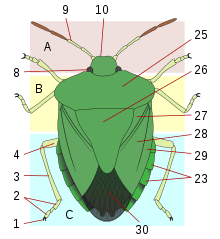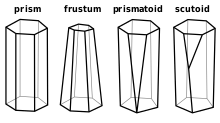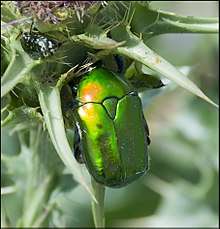Scutoid
A scutoid is a geometric solid between two parallel surfaces. The boundary of each of the surfaces (and of all the other parallel surfaces between them) is a polygon, and the vertices of the two end polygons are joined by either a curve or a Y-shaped connection on at least one of the edges, but not necessarily all of the edges. Scutoids present at least one vertex between these two planes. Scutoids are not necessarily convex, and lateral faces are not necessarily planar, so several scutoids can pack together to fill all the space between the two parallel surfaces. They may be more generally described as a mix between a frustum and a prismatoid.[1][2]



Naming
The object was first described by Gómez-Gálvez et al. in a paper entitled Scutoids are a geometrical solution to three-dimensional packing of epithelia, and published in July 2018.[1] Officially, the name scutoid was coined because of its resemblance to the shape of the scutum and scutellum in some insects, such as beetles in the subfamily Cetoniinae.[1] Unofficially, Clara Grima has stated that while working on the project, the shape was temporarily called an Escu-toid as a joke after the biology group leader Luis M. Escudero.[3][4] Since his last name, "Escudero", means "squire" (from Latin scūtārius = shield-bearer), the temporary name was modified slightly to become "scutoid".
Appearance in nature
The shape, however odd, is a building block of multicellular organisms; complex life might never have emerged on Earth without it.
— Alan Burdick, We Are All Scutoids: A Brand New Shape, Explained[2]

Epithelial cells adopt the "scutoidal shape" under certain circumstances.[1] In epithelia, cells can 3D-pack as scutoids, facilitating tissue curvature. This is fundamental to the shaping of the organs during development.[1][5][6]
"Scutoid is a prismatoid to which one extra mid-level vertex has been added. This extra vertex forces some of the "faces" of the resulting object to curve. This means that Scutoids are not polyhedra, because not all of their faces are planar. ... For the computational biologists who created/discovered the Scutoid, the key property of the shape is that it can combine with itself and other geometric objects like frustums to create 3D packings of epithelial cells."
- Laura Taalman[7][8]
Potential uses
The scutoid explains how epithelial cells (the cells that line and protect organs such as the skin) efficiently pack in three dimensions.[1] As epithelial tissue bends or grows, the cells have to take on new shapes to pack together using the least amount of energy possible, and until the scutoid's discovery, it was assumed that epithelial cells packed in mostly frustums, as well as other prism-like shapes.[3] Now, with the knowledge of how epithelial cells pack, it opens up many new possibilities in terms of artificial organs. The scutoid may be applied to making better artificial organs, allowing for things like effective organ replacements, recognizing if a person's cells are packing correctly or not, and ways to fix that problem.[3]
References
- Gómez-Gálvez, Pedro; Vicente-Munuera, Pablo; Tagua, Antonio; Forja, Cristina; Castro, Ana M.; Letrán, Marta; Valencia-Expósito, Andrea; Grima, Clara; Bermúdez-Gallardo, Marina (27 July 2018). "Scutoids are a geometrical solution to three-dimensional packing of epithelia". Nature Communications. 9 (1): 2960. doi:10.1038/s41467-018-05376-1. ISSN 2041-1723. PMC 6063940. PMID 30054479.CS1 maint: ref=harv (link)
- Burdick, Alan (30 July 2018). "We Are All Scutoids: A Brand-New Shape, Explained". The New Yorker. Retrieved 3 August 2018.
- standupmaths (3 August 2018). "THE SCUTOID: did scientists discover a new shape?". Retrieved 3 August 2018 – via YouTube.
- Supplementary Movie from Gómez-Gálvez et al. 2018, Electronic supplementary material
- Boddy, Jessica. "The 'Scutoid' Is Geometry's Newest Shape, and It Could Be All Over Your Body". Gizmodo. Retrieved 29 July 2018.
- "Scientists have discovered a brand-new three-dimensional shape". Newsweek. 27 July 2018. Retrieved 29 July 2018.
- Taalman, Laura [@mathgrrl] (28 July 2018). "Have you read the @Nature article introducing the new mathematical shape called the SCUTOID? This cutting-edge science is now 3D printable: www.thingiverse.com/thing:3024272" (Tweet). Retrieved 3 August 2018 – via Twitter.
- Taalman, Laura. "Pair of Packable Scutoids by mathgrrl on Shapeways". Shapeways.com. Retrieved 3 August 2018.